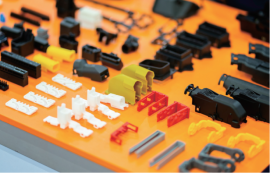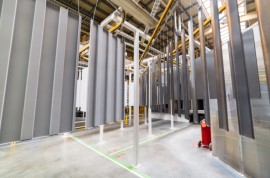Powder coating has been known since the 1950s and has made great progress. In recent years, powder coating technology has developed in many manufacturing fields in Vietnam. This article will provide you basic knowledge, current situation and development direction of Vietnamese enterprises on powder coating technology in the coming time.
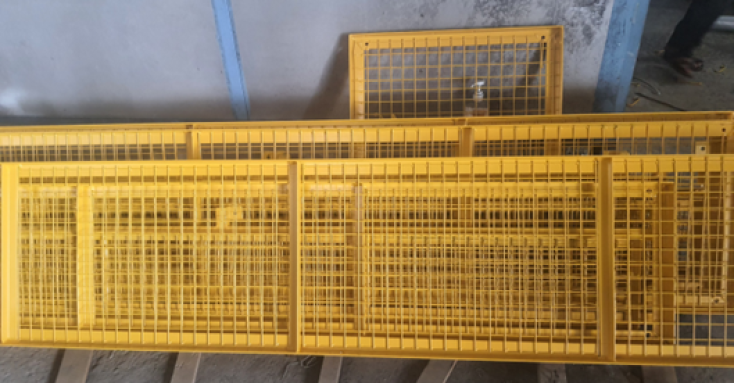
(Product after powder coating)
1. Overview of Powder Coating Technology
Principles of Powder Coating
Powder coating is actually known as a method of applying the surface of a material (metal or non-metal) with coating composed of polymer resins, pigments, additives by electrostatic method. Or it is also known as a method of applying a dry powder (negative charge) to surface of the material (positive charge).
Powder Coating Process 
Powder Coating Application
Powder coating is used for non-metallic materials such as plastic, wood, mica etc. However, it is mostly used for metal parts such as steel, aluminum, zinc, copper etc. Due to the outstanding advantages of powder coating compared to conventional liquid paint method, nowadays, powder coating is widely applied in many different fields such as:
- Furniture and decoration products
- Structural products for outdoor use: fences, gates, railings
- Industrial products: electrical cabinets, ladders, trough
- Automotive, motorcycle, bicycle industry
2. The reality of enterprises in the North that have been using powder coating system
There are two coating methods to protect surface of product before being delivered to the consumers: conventional liquid paint and powder coating. The conventional liquid paint is still being used by small enterprises or due to the specific nature of the product and customer requirements. Meanwhile, most of the rest manufacturing enterprises are using powder coating technology, especially for specific fields that require high product quality such as electrical cabinets, ladders, troughs, steel structures, household appliances, automobiles, motorbikes. However, due to many different reasons such as investment costs, surface area of painting area, some enterprises cut down the stages of the powder coating process.
There are 2 types of enterprises that will invest in powder coating systems. The first is the enterprise specializing in powder coating for other businesses. They will focus mainly on meeting the needs of customers, factories, small businesses that have the need of powder coating. Their main products are railings, gates, stairs, fences etc. There are not many enterprises specializing in powder coating. Most of them are enterprises with small scale, narrow factory area, incomplete and insufficient technology. The second is the enterprises that manufacture mechanical products, they invest in powder coating system mainly for internal production activities. These are large enterprises with large annual output.
According to the author's survey, most enterprises in the Northern region have powder coating system with semi-automatic or manual operation. It means that the system is incomplete or the enterprise has cut down a lot of stages which makes the quality and productivity of the powder coating still dependent on the qualifications and skills of the workers. Only a few large, synchronous and modern enterprises have an automatic and complete powder coating system. Here are some evaluations and comments about the powder coating stages from enterprises in some northern provinces that the author surveyed.
Surface cleaning
This is a very critical stage of the painting process in general and the powder coating process in particular. Even though, many enterprises cut down this stage or do it in a very poor way and with outdated technology. This stage includes the tasks such as depaneling bavia, removing the rust and oxidation layers. Many enterprises only use hand-held grinders and iron brushes to clean metal surfaces, meanwhile, ball blasting or sandblasting systems are being used in large enterprises. This is the optimal cleaning measure to increase productivity, the adhesion of the paint layer to the surface, to prolong product life and to protect the environment as well as the health of workers. However, the investment cost is high and the implementation needs to depend on the product size and shape. Small enterprises that do not identify their strong, traditional and typical products will often not invest in. Even large enterprises (such as Lilama Corporation, Lisemco, Song Da, etc.) invest asynchronously. While there are many enterprises applying automatic shot blasting, some others still do it manually.
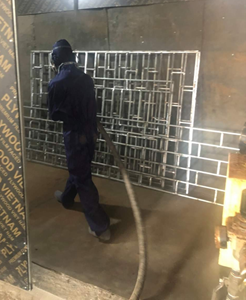 (Cleaning by sandblasting)
(Cleaning by sandblasting)
After being cleaned surface, the product will be put into the dip tanks to remove grease and dust. They often include acid tank for rust remover, water tank, degreasing tank, chemical tank. The order of cleaning through the dip tanks is as follows: Degreasing tank → water tank → shaping tank → phosphate tank → water tank. In fact, this stage is being performed inconsistently and synchronously at enterprises. Some enterprises do not have any dip tanks, or only have 1 or 2 dip tanks. Product characteristics (for example size and shape), business size and industrial wastewater treatment are also difficulties for enterprises when investing in dip tanks. For products such as balustrades, gates, large steel structures, a large tanks is required. This is a big problem for small enterprises without traditional and typical products.
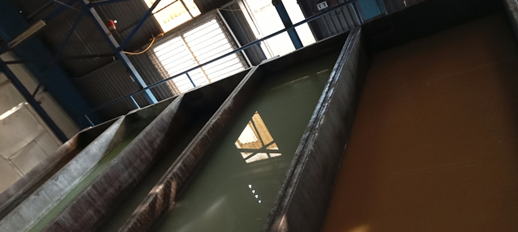 (Dip tanks)
(Dip tanks)
Drying
After being cleaned, the metal surface will be dried. Some drying methods are being applied such as infrared drying, gas drying, and natural drying. The gas drying method is to use a gas torch (being used at HTCO Company). This method is simple and highly effective. Products are hung on the conveyor system, pass through the drying oven with controlled temperature. Drying speed is fully automatic. The natural drying method is only applicable to thin sheet metal with small size.
All drying methods have different advantages and disadvantages, however, some enterprises do it in a manual and sketchy way, affecting the adhesion of the paint layer to the surface of the product.
(To be continued)
Written by Nguyen Hoang Hang (NC Network Vietnam)
















